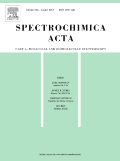
SPECTROCHIMICA ACTA PART A-MOLECULAR AND BIOMOLECULAR SPECTROSCOPY
Scope & Guideline
Advancing the frontiers of molecular and biomolecular spectroscopy.
Introduction
Aims and Scopes
- Molecular Spectroscopy Techniques:
The journal extensively covers various molecular spectroscopy techniques, including but not limited to UV-Vis, IR, Raman, and fluorescence spectroscopy. These techniques are employed to investigate molecular interactions, structural properties, and dynamic behaviors of different compounds. - Biomolecular Applications:
A significant focus on applications of spectroscopy in the biomedical field, including the detection of biomarkers, drug interactions, and the imaging of biological samples. This includes the use of fluorescence and SERS (Surface-Enhanced Raman Spectroscopy) for real-time monitoring of biological processes. - Environmental Monitoring and Safety:
Research that utilizes spectroscopic methods for environmental applications, such as the detection of pollutants, food safety assessments, and monitoring of agricultural products, is a core area of interest. - Nanomaterials and Sensor Development:
The journal features studies on the development of novel nanomaterials and sensors that enhance the sensitivity and specificity of spectroscopic techniques. This includes the synthesis of carbon dots, metal-organic frameworks, and nanocomposite materials for sensing applications. - Computational Spectroscopy and Theoretical Studies:
In addition to experimental studies, the journal publishes research involving computational methods to predict and analyze spectroscopic behavior, enhancing the understanding of molecular interactions and dynamics.
Trending and Emerging
- Smartphone and Portable Spectroscopy:
Recent publications highlight an emerging trend towards the development of portable spectroscopic devices and smartphone applications. This trend is driven by the need for accessible and on-site analytical tools for various fields, including environmental monitoring and healthcare. - Integration of Machine Learning and AI:
The integration of machine learning and artificial intelligence with spectroscopic techniques is gaining traction. This includes using AI for data analysis, predictive modeling, and enhancing the accuracy of spectroscopic measurements. - Advanced Nanomaterials for Sensing:
There is a notable increase in research focusing on advanced nanomaterials, such as metal-organic frameworks and carbon-based nanomaterials, for enhancing the sensitivity and selectivity of spectroscopic sensors. - Biomolecular Imaging and Diagnostics:
The application of spectroscopy for biomolecular imaging and diagnostics is on the rise. This includes the development of fluorescent probes for disease detection and monitoring, especially in the context of cancer research. - Eco-friendly and Sustainable Methods:
A growing number of studies are focusing on eco-friendly and sustainable spectroscopic methods. This includes the use of green solvents and materials in the development of spectroscopic sensors and methodologies.
Declining or Waning
- Traditional Spectroscopy without Novel Applications:
There has been a noticeable decrease in papers focusing solely on traditional spectroscopic methods without associated novel applications or advancements. Researchers are increasingly integrating spectroscopy with advanced technologies or methodologies. - Basic Spectroscopic Studies:
Research that primarily focuses on basic spectroscopic studies, such as simple spectral characterization without practical applications or implications, is becoming less frequent. The trend is towards studies that combine spectroscopy with real-world applications. - Limited Focus on Fixed Laboratory Settings:
Papers that involve only fixed laboratory settings for spectroscopy without consideration of field applications or portable technologies are declining. There is a growing preference for studies that emphasize on-site analysis and real-time monitoring.
Similar Journals

ATOMIC SPECTROSCOPY
Catalyzing Breakthroughs in Analytical Chemistry.ATOMIC SPECTROSCOPY is a distinguished journal specializing in the field of spectroscopy and published by ATOMIC SPECTROSCOPY PRESS LTD. With ISSN 0195-5373 and e-ISSN 2708-521X, this journal has been a cornerstone in advancing the discipline since its inception, thriving in its relevant domain for over four decades, covering converged research years from 1980 to 1989 and from 1996 to 2024. Currently holding a Category Quartile of Q2 in Spectroscopy for 2023, ATOMIC SPECTROSCOPY ranks 34th among 76 in its field according to Scopus, placing it in the 55th percentile, thereby affirming its critical role as a resource for researchers, professionals, and students alike. This journal serves as a platform for disseminating innovative research, methodological advancements, and breakthroughs in atomic and molecular spectroscopy, fostering a comprehensive understanding that is essential for progress in analytical chemistry and related disciplines. While it operates under a non-open access model, the journal ensures broad reach and visibility within the academic community. For those passionate about spectroscopy, ATOMIC SPECTROSCOPY remains an invaluable resource for staying updated on the latest developments, contributing to its reputation as a leading journal in the field.
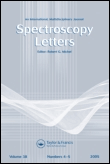
SPECTROSCOPY LETTERS
Unveiling Innovations in Spectroscopy Since 1968SPECTROSCOPY LETTERS, published by Taylor & Francis Inc, is a pivotal journal that plays a significant role in the fields of Analytical Chemistry, Atomic and Molecular Physics, and Optics. With an ISSN of 0038-7010 and E-ISSN of 1532-2289, it provides a platform for the dissemination of cutting-edge research and developments in spectroscopy and its wide-ranging applications. As of 2023, the journal is ranked in the third quartile (Q3) across its relevant categories, reflecting its importance in these scientific domains. The journal has a continuous publication history from 1968 to 2024, establishing a rich legacy in academic literature. Although it currently does not offer Open Access options, SPECTROSCOPY LETTERS remains a valuable resource for researchers, professionals, and students seeking to advance their knowledge and applications in spectroscopy. For those in the arena of physics and chemistry, this journal is essential for keeping abreast of the latest findings and methodologies in the field.

JOURNAL OF NEAR INFRARED SPECTROSCOPY
Fostering Excellence in Spectroscopic ResearchJOURNAL OF NEAR INFRARED SPECTROSCOPY, published by SAGE PUBLICATIONS LTD, is a leading platform dedicated to advancing the field of near-infrared spectroscopy, a pivotal technique for various applications in chemical, food, and agricultural analyses. With its ISSN 0967-0335 and E-ISSN 1751-6552, this highly respected journal publishes innovative research and review articles that contribute to the understanding and application of spectroscopic methods. The journal has maintained a respectable Q3 ranking in the Spectroscopy category and has a Scopus rank of #51/76 in Chemistry _ Spectroscopy, placing it within the 33rd percentile. This positions the journal as an essential resource for researchers, professionals, and students looking to stay informed on the latest advancements and methodologies in near-infrared spectroscopy. Although the journal currently does not offer open access options, it is pivotal for fostering knowledge exchange and collaborative research within its community. With convergence spanning from 1996 to 2024, it continues to be a reliable source of impactful academic content.
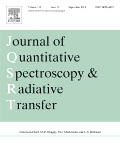
JOURNAL OF QUANTITATIVE SPECTROSCOPY & RADIATIVE TRANSFER
Bridging theory and application in spectroscopy and optics.JOURNAL OF QUANTITATIVE SPECTROSCOPY & RADIATIVE TRANSFER is a prestigious academic journal published by PERGAMON-ELSEVIER SCIENCE LTD that serves as a leading forum for advancements in the fields of atomic and molecular physics, optics, and spectroscopy. With a commitment to publishing high-quality research since its inception in 1961, this journal has consistently contributed significant insights, furthering our understanding of the interactions between light and matter. Currently holding a Q2 ranking in Atomic and Molecular Physics and Optics, and Q1 in Radiation, this journal ensures a robust platform for researchers aiming to disseminate their findings and collaborate in this evolving field. With rigorous peer-review processes and a strong emphasis on quantitative methodologies, it is ideal for both emerging scholars and established professionals alike. Although it does not offer Open Access options, the journal remains an essential resource for anyone engaged in the rapidly advancing domains of quantitative spectroscopy and radiation studies.
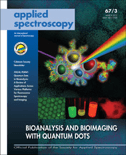
APPLIED SPECTROSCOPY
Advancing the Frontiers of SpectroscopyApplied Spectroscopy, published by SAGE Publications Inc, is a leading journal in the field of spectroscopy and instrumentation, with a legacy dating back to 1970. This esteemed journal, recognized within the Q2 category for both Instrumentation and Spectroscopy in 2023, provides critical insights and advancements that cater to a wide audience of researchers, professionals, and students. With its Scopus rankings placing it in the top 20% of publications in its respective fields, Applied Spectroscopy stands out for its rigorous peer-reviewed content that drives innovation in analytical techniques and applications. Though not an open-access publication, readers can access a wealth of research articles, reviews, and experimental findings that enrich the scientific discourse in spectroscopy. With a focus on enhancing the understanding and practical applications of spectroscopy, this journal is an essential resource for anyone engaged in this dynamic and evolving discipline.

SPECTROSCOPY
Pioneering Insights in Analytical Chemistry and PhysicsSPECTROSCOPY is a vital peer-reviewed journal published by MJH Life Sciences, dedicated to advancing the field of spectroscopy and its applications across various disciplines including analytical chemistry, atomic and molecular physics, and optics. Established with a vision to disseminate cutting-edge research, the journal has a broad scope that encompasses the latest developments, methodologies, and technologies in spectroscopy. Although positioned in the Q4 quartiles for its categories as of 2023, it remains an important resource for researchers and students alike, providing insights into emerging trends and challenges in the field. Issues are published regularly, facilitating knowledge exchange and collaboration among professionals. With access options available in traditional formats, SPECTROSCOPY strives to reach a diverse audience, underscoring its relevance and necessity in today’s ever-evolving scientific landscape. For those in pursuit of innovative solutions and comprehensive analyses in spectroscopy, this journal serves as an indispensable platform.

ANALYTICAL AND BIOANALYTICAL CHEMISTRY
Pioneering Innovative Research in ChemistryANALYTICAL AND BIOANALYTICAL CHEMISTRY, published by SPRINGER HEIDELBERG, is a leading international journal that serves as a vital platform for innovative research in the fields of analytical and bioanalytical chemistry. With an impressive impact factor and ranking in the Q2 category for both Analytical Chemistry and Biochemistry, the journal highlights key advancements and methodologies that drive the discipline forward. Established in 1996 and continuing vigorously into 2024, it has gained significant recognition with Scopus rankings placing it in the 83rd and 78th percentiles within its categories, underscoring its impact and relevance. The journal's commitment to open access facilitates widespread dissemination of critical scientific knowledge, making it an essential resource for researchers, professionals, and students dedicated to exploring the complexities of chemical analysis. With its base in Heidelberg, Germany, ANALYTICAL AND BIOANALYTICAL CHEMISTRY continues to inspire and influence the global research community.
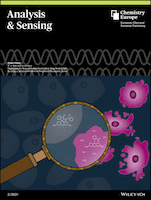
Analysis & Sensing
Pioneering Research in Sensing and AnalysisAnalysis & Sensing is a prominent academic journal published by WILEY-V C H VERLAG GMBH, focusing on the critical fields of Analytical Chemistry, Electrochemistry, Spectroscopy, and Biochemistry. Established within the converged years from 2021 to 2024, the journal aims to advance knowledge in analytical and sensing techniques, providing a platform for high-quality research that reflects current trends and challenges in the scientific community. With a Scopus ranking that highlights its credibility—ranking 101st in Analytical Chemistry and 43rd in Electrochemistry—the journal caters to researchers, professionals, and students striving to enhance their understanding of analytical processes and methodologies. Although not open access, the quality of the articles published ensures a rigorous peer-review system, making it a vital resource for those who wish to remain at the forefront of research innovation in analytical sciences. Additionally, its global reach, indicated by its effective dissemination and relevance, underscores the journal's significance within the realm of chemical research.
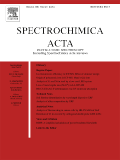
SPECTROCHIMICA ACTA PART B-ATOMIC SPECTROSCOPY
Catalyzing Breakthroughs in Spectroscopic Methodologies.SPECTROCHIMICA ACTA PART B-ATOMIC SPECTROSCOPY, published by PERGAMON-ELSEVIER SCIENCE LTD, is a leading peer-reviewed journal dedicated to advancing the field of atomic spectroscopy. With a respectable impact within its category—achieving Q2 quartile rankings in Analytical Chemistry, Atomic and Molecular Physics, Instrumentation, and Spectroscopy according to the 2023 metrics—this journal plays a pivotal role in disseminating high-quality research findings. Over its impressive publication history since 1967, the journal has continuously provided a platform for researchers to present innovative methodologies, theoretical advancements, and practical applications related to atomic spectroscopy. The journal is recognized for its rigorous peer-review process and aims to foster scholarly dialogue among professionals and students alike, reinforcing its significance in the scientific community. Although it does not offer open access options, its strong presence in notable databases ensures that the research reaches a broad audience. As a part of the ongoing dialogue in atomic and molecular sciences, SPECTROCHIMICA ACTA PART B is an essential resource for those at the forefront of related research.

Journal of Biophotonics
Transforming Science Through the Power of LightJournal of Biophotonics is a prestigious academic journal published by WILEY-V C H VERLAG GMBH in Germany, dedicated to advancing the field of biophotonics through high-quality research. With an ISSN of 1864-063X and an E-ISSN of 1864-0648, this journal is recognized for its contributions within diverse categories, including biochemistry, genetics, molecular biology, chemistry, engineering, materials science, and physics, earning a commendable Q2 ranking in several of these fields as of 2023. The journal aims to bridge the gap between theoretical research and practical applications, fostering interdisciplinary collaboration that is critical for innovations in imaging, diagnostics, and therapeutics. Researchers, professionals, and students alike will find the Journal of Biophotonics invaluable for staying informed about the latest developments and breakthroughs in this dynamic field, making it a cornerstone for knowledge dissemination and scholarly discourse from its inception in 2008 and continuing through 2024.